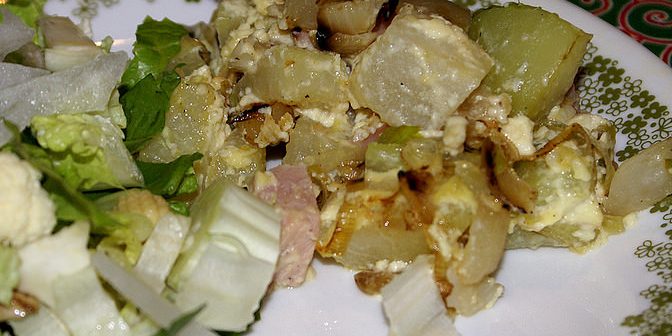
For a quick, but tasty meatless meal, this easy skillet dish comes together in about thirty minutes. Starting with a frozen vegetable base, you can stir fry it, add in the fresh vegetables, make a cream sauce with cheese, and serve three people. If you want, you can make a flat bread, like this one, to go with it.
If you’re not worried about staying meatless, you can add in sliced sausages, bacon, or ham. Or you can add in shrimp and still count it as meatless.
The key in this is having the celery root peeled and cubed before you begin cooking. It will take the most time of any of your prep. But it brings a slight celery flavor along with a texture similar to potatoes, that gives this dish a unique, but delicious component. If you want to skip this, you can replace with sliced celery or chopped turnips.
I used cheddar cheese, but you can vary with other ones to change the flavor of the dish slightly. If you use an Italian cheese, change the seasonings to an oregano mix to bring in that flavor profile. With Mexican cheese, add in more chili spice to give it more bite.
Garden Vegetables with Cheese Sauce
1 10–oz package frozen Cauliflower, Broccoli & Carrot Mix
1 cup Celery Root, cubed into 1/2″ inch pieces
1/2 cup Asparagus, chopped
1/2 tablespoon Olive Oil
1 teaspoon Minced Garlic
1/2 cup Vegetable Broth or Better than Bullion Vegetable base
1/4 cup Heavy Cream
1/2 cup Cheddar Cheese
1 teaspoon Low Carb Flour or Corn Starch
1 teaspoon Seasoning Salt or Mrs. Dash
1/4 teaspoon Red Pepper Flakes
1/4 teaspoon Black Pepper
Partially cook the frozen vegetables in a microwave so they are defrosted. Cook the cubed celery root for 1 minute in the microwave. This will speed up the cooking time on the stove.
In a medium skillet, heat the olive oil over medium high heat and add the garlic. Cook for about 20 seconds, then add the vegetables to the pan. Stir and cook the vegetables for a few minutes, then add the vegetable broth and bring to a boil, then lower the heat to simmer. Add seasoning and let cook for about ten minutes until the vegetables begin to soften.
In a cup, add 1/4 cup water and flour or corn starch, then stir to mix. Add the cream to the pan, then add the water mixture. Stir into the vegetables. This will begin to thicken after a few minutes. Add the cheese and stir in to make the cheese sauce. Cook a few minutes until it’s a thick sauce, then serve.
Makes 3 servings.




